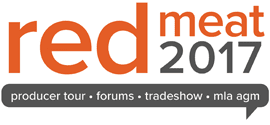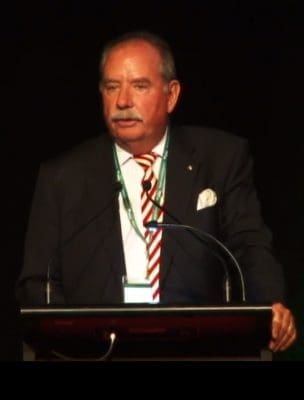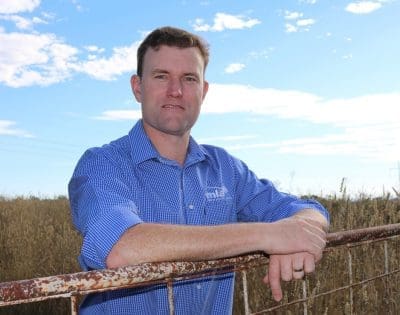ANIMAL welfare, ways to improve technology adoption and how to cultivate better collaborative supply chain relationships were the front-of-mind challenges raised by red meat producers during question time at industry forum sessions held yesterday in Alice Springs as part of the annual industry AGMs.
 More than 400 red meat producers and other industry stakeholders from all states and territories gathered for the event. That made it one of the better-attended AGMs in recent times – somewhat surprising, given the remoteness of this year’s location.
More than 400 red meat producers and other industry stakeholders from all states and territories gathered for the event. That made it one of the better-attended AGMs in recent times – somewhat surprising, given the remoteness of this year’s location.
Here’s a snapshot of the front-of mind questions raised by producers during the RMAC and MLA forum sessions, the industry breakfast, and the MLA annual general meeting:
Animal welfare challenge
New England livestock producer James Jackson said he had a concern over how the red meat industry was handling the animal welfare issue, which he described as more ‘reactive’ than ‘proactive.’ “You’re essentially reacting to an agenda set by animal liberationists, which I suggest is a dangerous thing,” he said.
CCA’s president Howard Smith said he felt the industry had recently been reasonably pro-active surrounding the animal welfare issue, pointing to the addition of two extra modules within the Livestock Production Assurance program covering national standards and guidelines on animal welfare and biosecurity.
“That’s taken a long time to reach agreement on, following negotiation across and industry and with the RSPCA. It’s been a good early step, in demonstrating that we take welfare seriously in this country,” he said.

RMAC chair Don Mackay
RMAC chair Don Mackay said animal welfare remained one of the ‘really important’ questions that the industry had to deal with.
“I don’t see us being defensive to your question at all,” he said, “but we haven’t got it all right yet, by a long shot.”
“Nor do I think our communication of the importance of this to the entire sector has been adequate, to this point. The new LPA module covering animal welfare is a good example. Why are we doing this? We need to make sure that everybody understands, absolutely.
“It’s not simply about protecting the Australian red meat industry’s position, but putting it in a pre-eminent competitive position. We are better placed than any other competitor to do that, when trying to access markets like Europe, where the Argentineans and Brazilians are all trying to charge through the same door as us.”
Mr Mackay said while the industry worked closely with groups like RSPCA, he would not engage with interest groups whose agenda was to ‘close the red meat industry down.’
“We need to understand why groups like Animals Australia want to try to close us down – absolutely – but they are ‘just not the right sort of stakeholder’ to engage with on the topic.”
ALFA president Tess Herbert said animal welfare was now front-of-mind for lotfeeders, and all along the supply chain.
“The industry has been remarkably proactive in this space, but I agree – we need to do more. We need to be more aware of what our customers and stakeholders are saying, and engage more in what they are seeing, that maybe we aren’t,” Ms Herbert said.
“Animal welfare is not negotiable, on a couple of levels,” she said. “Overseas customers are increasingly requiring increased animal standards and guidelines around our product. But it’s also on a ‘values’ level. It’s something that we all need to get our head around – how that looks.”
Within the grainfed industry, lotfeeders had recently strengthened animal welfare standards within its dedicated module within the National Feedlot Accreditation Scheme.
“We liaise with RSPCA at least once or twice a year. What we are trying to do is be on the front-foot, and be pro-active, and figure out what our stakeholders and customers are saying about our production systems. We recognise that as an intensive industry, that may be more challenging,” she said.
“We absolutely applaud industry for the introduction of the two new LPA modules, and it starts with being underpinned by our standards and guidelines, and then the LPA modules on welfare and biosecurity work further, to enhance that.”
“We can all individually do what we do in the animal welfare space, but its really important across the supply chain that we also address issues collectively.”
She said she could not imagine that lotfeeders would ever reduce the animal welfare components within NFAS – “it will continue to increase, and that is just the reality of where animal welfare standards are at.”
Australian Meat Industry Council chairman Lachie Hart said the processing industry had adopted a voluntary animal welfare standard that currently accounted for 84pc of all cattle slaughtered.
“We’re now starting to see that accreditation adopted by some of our end-user customers around the world, but also here in Australia, with retailer Aldi making it a pre-requisite for supply into stores,” he said.
ALEC chair Simon Crean said the live export sector had been active on a number of fronts, successfully calling for the government to initiate a review into ACIL, covering standards for the carrying of animals within Australia, initiated this year.
“We’ve engaged with animal welfare vets to identify holes in the system where that can be addressed, and Livecorp has done some really good work in bringing together the work done some years ago that identified where the differences were on this, as to how the industry can improve on that front,” he said.
“Outside of Australia, we have indeed been proactive. Last week in Perth the annual meeting of ALEC members endorsed unanimously a move to a global assurance program for animal welfare in live export, under the LGAP program. Of the 130 countries globally live exporting livestock, Australia is the only one where the exporter is responsible for the welfare of the animal up to the point of slaughter. What we’re about doing is requiring the facilities in-country to take more responsibility for the welfare of animals, through control and traceability systems.”
Discussions around animal welfare also focussed on the government’s new Independent Office of Animal Welfare, and how it might look.
“The devil will be in the detail – in how it looks and functions,” ALFA’s Tess Herbert warned.
Supply chain relationship-building
Sheep producer Ian McColl asked how the industry might better address the need for effective supply chain relationships.
“It’s a question that has to be answered, and it’s one of the key components in the challenge of what will make us, as an industry better,” RMAC’s Don Mackay said.
“Whether everybody is going to get there, I accept it probably won’t happen. But a large chunk of industry needs to get there”
“The reality is that there are already people in this room who have long-term relationships with the next points in the chain in their business already. They are getting strong feedback; making good decisions based on that feedback; not always getting the peak price, but avoiding the lowest price; and working with that partner under a level of trust. That’s where we, as an industry are moving.”
“But whether everybody is going to get there, I accept it probably won’t happen. But a large chunk of industry needs to get there, and I’m sure that those people who have those relationships are not the ones complaining or concerned about recent industry issues – they are working feverishly on improving and growing their business.”
Mr Mackay said Australia had a general point of difference with a ‘brand’ identity that was second to none, but at an individual level, it was “all about becoming part of a chain.”

AMIC chair Lachie Hart
AMIC’s Lachie Hart said he was part of the ‘infamous’ Barry O’Sullivan tour of North Queensland last year, and as a processor rep on that tour, he said he was anticipating a ‘fair bit of feedback’ from producers with regard to relationships with processors.
“It was at a time when processors were under a lot of pressure form the Senators, and the inquiries that were happening. But a lot of the feedback was not necessarily about the processors themselves, but representation, and ensuring that the voice of producers was being carried through to government and decision-makers,” he said.
“From that, I think the collective industry has moved forward. We have learned a lot from the ACCC inquiry and the Senate inquiry, and as leaders of this industry, there needs to be a lot more collaboration and consultation, up and down the supply chain.”
“We’re seeing processors going forward, and Teys’s example this morning about moving down the Value-Based Marketing path, and developing levels of trust is a good example,” Mr Hart said.
“But from AMIC’s perspective, we understand that processors are just a part of the supply chain. We have agricultural inputs in cattle, sheep and goats, and need to collaborate up and down that chain to ensure that not only is the industry sustainable, but that every sector is going to hopefully iron-out these boom and bust cycles that we currently all experience, allowing our businesses to go forward.”
ALFA’s Tess Herbert acknowledged the ‘vagaries of the supply chain’ which would continue to exist, but said it was in nobody’s interest for any link in the supply chain to fall over. “We need each other to survive, and have to look at each other as customers – not the enemy,” she said.
CCA’s Howard Smith said he felt the industry was moving in the right direction, but “really needed to have a mature conversation” to ensure it did not have the repeats of the past four or five years, where one sector was winning and the other losing.
“When are we going to have a mature debate and say let’s look at policies that tries to iron out those lumps and steep hollows. We’ll never get rid of volatility entirely, but there has to be somewhere where we can agree that we are all in this together, and it’s not a win-loss outcome.”
Challenge in technology uptake
A southern livestock producer asked the peak council representatives to address the challenge of low industry adoption of new technologies, which he claimed were 5-10pc in some cases.
Red Meat Advisory Council chair Don Mackay drew attention to the cotton industry, where use of paid consultants with specialised expertise was commonplace.
“There is a very well developed consultancy system in many areas of agriculture. In a cotton business I am involved in, we employ perhaps 15 or 20 agronomists. In the grainfed sector, no major feedlot does not have a consultant veterinarian and nutritionist, giving absolute up to date information at their fingertips every day.
“In my view, governments with the exception of the NT are highly unlikely to pick this up. We collectively have to work to provide some means by which commercial operators can be part of this solution. I know a lot of the production industry does not like to think about employing advisors or consultants, but in most other sectors – particularly intensive – it’s a part of normal life.
“That’s one of the ways we have to do it. Where there is market failure – and I think there is market failure here – we need to get some intervention (Mr Mackay referenced government or industry funds) to kick-start things. That’s something that the RMAC members should certainly consider, and it’s a topic we have raised around the table, and will continue to do so.”
“We just have to get the adoption challenge met. Some of this technology is now 20 years old, and we’re still not using it, and that’s the disappointing part.”
CCA’s Howard Smith said an opportunity might exist, as part of proposed industry restructure, to improve performance in the technology adoption space.
“Currently, most producers would not know who their regional R&D chairman is,” he said.
“I’ve been to MLA information days where, depending on how it is executed and what region it’s in, there can be either a full-house, or two people turn up.”
But if we can get more coordinated, and stop the duplication, making sure everybody is working together, we can get a better outcome.”
I believe with our service providers, governments and departments, if we can get boots on the ground that is region specific, and getting elected people from the new Cattle Australia organisation to be the point of contact, coordinating other groups, we can make progress in adoption.”
ALFA’s Tess Herbert said the number of R&D projects that ‘sat on a shelf’ was disappointing, given the levy funds that had been invested. But she saw enormous opportunity for industry to maintain a touch-point with grassroots producers by offering extension services.
“The extension space is an enormous opportunity. Using the grainfed sector as an example, while we use a lot of consultants, in actual fact we do a lot of the extension work with new technologies ourselves.
“I know that is much easier for the feedlot sector to do than for the extensive cattle industry (600 ALFA members located primarily in four or five main ‘pockets’) but we’re still a national body and have to reach our levy payers in every state.”
We run two workshops and a conference every year. If we change our NFAS standards for some reason we run a workshop. That’s because we don’t expect people to adopt a new standard, without informing and educating them exactly what it is about. Extension is one of the most valuable tasks that ALFA performs for members as a peak council, and I see it as a huge opportunity.”
New approaches to adoption model
Speaking during the following MLA forum session, general manager for the R&D adoption programs, Michael Crowley said MLA had a very clear strategy around what it was doing in the adoption space.

MLA’s general manager for producer consultation & adoption, Michael Crowley
The larger-scale awareness programs included Beef-Up forums, Pasture Updates and Ewe-Time forums, engaging with producers in large numbers in telegraphing research outcomes that were ready to adopt.
Then there was another category for shorter, more specialised courses over 1-3 days, like Business Edge, Grazing Land management and Nutrition Edge programs.
The third component is around assisted learning, with smaller numbers of producers engaging on a longer-term basis using a private consultant, targeted to their priorities. These operate as Producer Demonstration Sites, or under a new program called Profitable Grazing Systems.
A pilot PGS program had indicated that the average improvement for those involved was $30,000/year, across 96 businesses engaged over nine months.
Another new program called Producer Innovation Fast-Track managed through the MLA Donor Company (dollar-for-dollar funding required from participants) had an original budget of $4 million, but had attracted $16 million worth pf project proposals in the first round.
“It highlights to me that producers really are willing to put money on the table in this area, and challenges our traditional models of driving adoption,” Mr Crowley said.
“But we need to take a different approach to adoption: a whole-farm system approach, and a value-chain approach in our adoption strategy, and move away from doing ‘feedbase’ work, or ‘genetics’ work, in isolation.”
“I’ll certainly be held accountable for the performance of the adoption program,” he said.



I really can not follow the spruiking about the new LPA modules. They are essentially worthless as they only mirror the state laws anyway.
Downloading a set of guidelines and checking a few boxes on the internet does not mean you are following the guidelines. It is like everything else, paperwork does not mean compliance, especially in industries where nothing can be independently checked.
A few years ago in Queensland a large drought ravaged the state. Tens of thousands of stock died of starvation. Would all these properties be banned from LPA under the new guidelines? My guess is it will be carry on as normal. Lest the producers get jack of LPA and start seeking advice whether LPA is even legal to begin with. (I wonder if it would survive a challenge under anti-competition laws as it deliberately stifles competition)